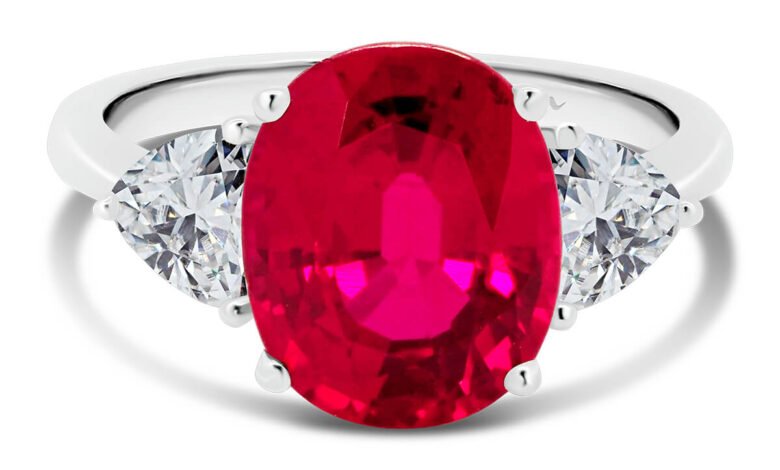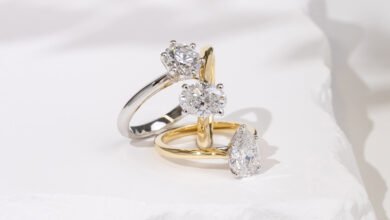Sparkling Science: The Definitive Guide to Lab-Created Ruby Rings

Introduction
Lab-created ruby rings bring together breathtaking color, ethical sourcing, and modern gem science. Unlike mined rubies, lab-created rubies are grown in controlled environments that replicate the natural processes which form corundum (ruby’s mineral family). The result is a gem with identical chemical, optical, and physical properties to natural ruby but often with fewer impurities, lower cost, and far clearer provenance. This article explains what lab-created rubies are, why they’ve become popular for rings, how to evaluate quality, and how to care for your piece. It’s written to meet Google’s E-E-A-T principles emphasizing experience, expertise, authority, and trustworthiness so readers and site owners can rely on it for accurate, actionable guidance. Whether you’re shopping for an engagement ring, expanding a jewelry collection, or writing ecommerce product pages, this guide will help you choose confidently.
What are lab-created rubies and how are they made?
Lab-created rubies are real rubies: they share the same chemical composition (aluminum oxide with chromium giving the red color), the same crystal structure, and the same hardness as mined rubies. The main difference lies in origin. There are two primary lab methods: flux growth and flame fusion (also called Verneuil). Flux growth mimics natural slow-cooling conditions, producing crystals that often show growth features similar to natural stones. Flame fusion melts powdered ingredients and deposits them rapidly, producing larger, more uniform crystals. Modern techniques like hydrothermal synthesis also yield high-quality rubies with excellent clarity and color. Because production occurs in controlled settings, manufacturers can reduce harmful mining impacts, offer consistent color ranges, and provide complete traceability. For consumers, that means transparent warranties, predictable pricing, and attractive stones with fewer inclusions. Importantly, reputable sellers will disclose the gem’s lab origin and often provide a laboratory certificate describing the synthesis method and gem properties.
Benefits of choosing a lab-created ruby ring
Choosing a lab-created ruby ring delivers several clear advantages: affordability, ethical sourcing, and quality control. Lab rubies generally cost a fraction of equivalent mined stones, allowing buyers to afford larger carat weights or superior cuts without stretching their budget. Ethical concerns surrounding mining such as environmental disruption and opaque labor practices are largely mitigated because lab production avoids large-scale excavation and supply-chain opacity. Quality-wise, lab rubies can offer exceptional color saturation and clarity; manufacturers can target the “pigeon’s blood” reds and consistent hue ranges that are rare and expensive in the natural market. For engagement rings or daily-wear pieces, lab-created rubies offer great durability (Mohs hardness 9) and color stability. Additionally, because producers control the growth environment, certification and provenance documentation tend to be clearer, supporting resale value and buyer confidence. Lastly, lab rubies make it easier for designers and custom jewelers to provide predictable outcomes for bespoke rings.
How to evaluate quality when buying a lab-created ruby ring
When evaluating a lab-created ruby ring, focus on color, cut, clarity, carat, and certification mirroring the classic “4 Cs” approach used for colored gems. Color remains the single most important factor: look for a vivid, well-saturated red without brown or orange overtones. Cut impacts face-up brilliance and symmetry; a skilled cutter can maximize color and hide internal features. Clarity in lab rubies tends to be better than in natural rubies, but examine stones for fractures, color zoning, or unusual synthetic growth patterns these are sometimes visible with a jeweler’s loupe. Carat weight matters for presence and proportion, but avoid oversized stones with thin cuts that reduce durability. Finally, insist on a laboratory report from a recognized gem lab (e.g., GIA, AGA, or equivalent) or a seller’s detailed certificate that clearly states “laboratory-created” and lists the synthesis method. Ethical policies, return windows, and written guarantees from the seller also factor into quality assessment the best vendors combine transparent lab reports with strong customer protections.
Caring for and insuring your lab-created ruby ring
Lab-created rubies are durable, but they still require proper care to keep them looking their best. Clean gently using warm soapy water and a soft brush; avoid harsh chemicals and ultrasonic cleaners if the stone has surface-reaching fractures or certain fillings. Remove your ruby ring during heavy manual tasks, while gardening, or during chemical exposure to prevent impacts or residue buildup. Store the ring separately from other jewelry to avoid scratches to the metal or stone. For settings like delicate halo designs, routinely check prongs and settings with a trusted jeweler loose prongs are the leading cause of lost stones. Consider insuring any high-value piece many home or specialty jewelry insurers cover replacement cost for lab-created gemstones, though policies can vary; document purchase receipts, certificates, and clear photographs to speed claims. Regular professional inspections (once a year) keep both the setting and the stone safe for everyday wear.
Conclusion
Lab-created ruby rings are an elegant, ethical, and economical alternative to mined rubies. They offer the same chemical and physical beauty as natural stones, with the added benefits of traceability, consistent quality, and lower environmental impact. Whether you prioritize budget, sustainability, or predictable aesthetics for an engagement ring or fashion piece, lab rubies deliver compelling value. To make a confident purchase, prioritize color, reputable certification, and a transparent seller policy. With proper care and documentation, a lab-created ruby ring can be a lasting, meaningful symbol that blends modern science with timeless style.
FAQs
Q: Are lab-created rubies real rubies?
A: Yes. Lab-created rubies are chemically, physically, and optically the same mineral as natural ruby; the distinction is their synthetic origin.
Q: Do lab-created rubies lose color over time?
A: No rubies (natural or lab-created) are color stable under normal wear. Avoid extreme heat or harsh chemicals to preserve settings and any surface treatments.
Q: How much cheaper are lab rubies compared to natural rubies?
A: Prices vary, but lab-created rubies can cost significantly less often a fraction of the price for comparable color and size natural stones allowing larger or higher-quality options within the same budget.
Q: Will lab-created rubies affect resale value?
A: Resale markets for lab gems are developing; while some buyers prefer natural stones, demand for lab-created gems is growing. Good documentation and brand reputation improve resale potential.
Q: Can a jeweler tell if a ruby is lab-created?
A: Experienced gemologists using proper equipment can distinguish lab-created from natural rubies; that’s why reputable sellers provide lab reports stating origin.



